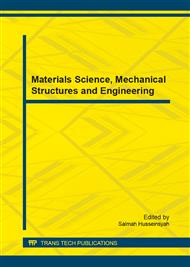p.131
p.135
p.140
p.146
p.150
p.154
p.160
p.167
p.171
Zinc Removal Using Honey Dew Rind
Abstract:
Heavy metals pollution in wastewater from agriculture and industrial waste has been a great concern due to their toxic condition and adverse effect to the environment and human life. One of the treatment of heavy metals through biosorption. In this study, zinc is the highest concentration heavy metal in mosaics wastewater with 350 - 450 mg/L and thus, it has been selected for further study for heavy metals removal. Honeydew rind was used as biosorbent material to remove zinc in the wastewater. Characterization and optimization study were carried out. The optimum condition for pH, biosorbent amount, concentration of wastewater and contact time are at pH 6, 1.5g adsorbent, 400 mg/L zinc and 30 minutes contact time respectively 63% zic removal. This finding indicates that honeydew rind is effectively acted as biosorbent in biosorption process for removing zinc from wastewater.
Info:
Periodical:
Pages:
150-153
Citation:
Online since:
October 2014
Authors:
Keywords:
Price:
Сopyright:
© 2014 Trans Tech Publications Ltd. All Rights Reserved
Share:
Citation:


